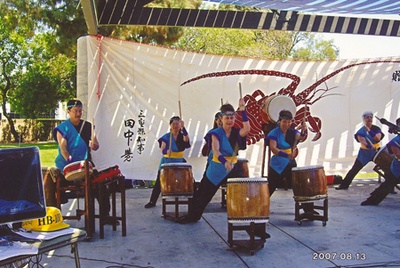On June 3, 1989, I married Shirley Takigawa and unknowingly, I became a permanent member of the Mie Kenjinkai. My family was originally from Yamaguchi Ken on my mother’s side and Tottori Ken on my father’s side, but I soon discovered I had just been drafted into the Mie Ken army.
It started out innocently enough: attending picnics, annual dinners and other functions until my mother-in-law asked if I would be able to help with a few activities. She said we needed to have more participation from younger members and that the tasks would be easy. I knew very little about the Mie Kenjinkai and did not even know what a Ken was. I only knew about Mie’s famous pearl divers. I thought that the Mie Kenjinkai was for senior adults who spoke Japanese, rather than for me, the younger American-born, English-speaking hipster. But being a good son-in-law, I served out of courtesy and respect for my in-laws and wife.
As with any other volunteer assignment, the list of duties soon began to increase. First, the Mie Kenjinkai needed a golf tournament, then help with picnic duties such as cooking and running the games. Finally, it expanded to any function that needed an English speaking representative.
At first this seemed like a lot of work, but as time passed, I began to enjoy the outings and most of all the people. I had great satisfaction in seeing my children enjoy themselves at the picnics and witnessing the seniors having fun at the golf tournaments. The pinnacle of my experiences was when the whole family, including Shirley’s parents, traveled and toured Mie Ken while on vacation. I was able to meet the Takigawa relatives in Mie, and had many fun dinners, drinking sake and beer. We toured the famous Ise temple, rode mini-racers on the Formula One Race Car Track at Suzuka Circuit, saw the only two rocks in the world that are married, and found a love of onsens while eating plenty of great food.
Three years ago, Mie Kenjinkai started the Mie Ken Student Exchange Program, with the generous help of Mr. Shigeo Takayama. My daughter and nephew were fortunate to go to Mie for two weeks. They had the time of their lives and matured as individuals. My daughter has often said that this was one of the best experiences of her life and continues to have a passion for Japan. I am very grateful to the Mie Kenjinkai for not only enriching my life, but more importantly, providing valuable experience and knowledge to my children about their heritage.
Mie Kenjinkai is growing older and soon, without the participation of younger members under the age of thirty-five, will cease to exit. The younger generation have assimilated into the American culture and busied themselves with activities, resulting in little need for a club that specializes in old traditions. Before, the kenjinkais were needed for social, financial, and protective functions from the outside world that harbored fear and prejudice of Japanese immigrants. These kenjinkais were the foundations of success for the Issei pioneers in America. Life is very different today, as few Sansei speak Japanese and are busy raising their own families. They see little benefit from a Japanese speaking club, and view Japan as a foreign nation they can learn about from the internet or on a tour during a vacation. What they fail to see is the sacrifice and determination of the Issei to make our lives comfortable in the United States. We also fail to recognize how our “roots” form the foundation of our lives.
Our task is very easy to identify but difficult to achieve. Our challenge is to recruit the youth of today to show them the benefits of their heritage and culture. When they come to recognize the courage and individual sacrifices of their grandparents, they will see the need for the Kenjinkai. Every journey has a start and the only way to begin is to remember its origin. It would be a great injustice if we lost sight of our heritage and appreciation for the progress that has made us successful today. The kenjinkais have much more to offer our youth, especially in discovering who they are and where they came from. Just like a great relay race, the baton is ready to be passed on to the youth of today; they only need to be recruited to enjoy the riches of victory.
©2009 Dean Hara




